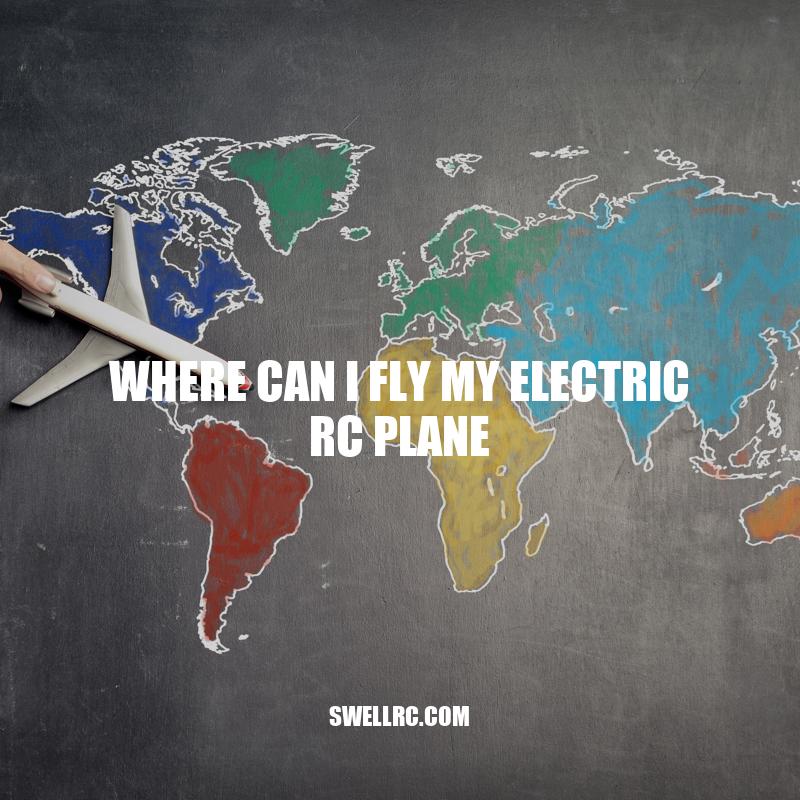Where to Legally Fly Your Electric RC Plane: A Guide
Electric RC planes are becoming increasingly popular hobbies as more people discover the joys of model aviation. A fun and adrenaline-pumping activity, flying an electric RC plane requires skill, concentration, and knowledge of rules and regulations to make sure everyone involved stays safe. However, finding a place to legally fly an electric RC plane can be challenging; each location comes with its own limitations and guidelines that must be followed. Before heading out to fly an electric RC plane, it’s crucial to conduct proper research into suitable locations and relevant regulations to avoid any legal or safety issues. This article provides information and guidance on places where electric RC planes can be flown legally and responsibly. Whether you’re a beginner or a seasoned pilot, this article will help you navigate the rules and find the perfect location for an exciting flight.
Join a Local RC Club
One of the easiest ways to find a safe and legal place to fly an electric RC plane is to join a local RC club. These clubs frequently have a designated flying site that has been approved by the FAA as safe for model aircraft flying. Here are a few things to keep in mind if you decide to go this route:
- Research local RC clubs and find one that accommodates your skill level and flying interests.
- Check the club’s membership fees and flying hours to ensure that they fit your schedule and budget.
- CAAMA’s flying site search can help you locate a club near you.
- Join the Academy of Model Aeronautics (AMA), which offers insurance and benefits for RC pilots who belong to a chartered club.
By joining a club, not only can you benefit from the legal and safe flying regulations offered, but you can also interact with experienced pilots who can help you improve your skills and enjoy the hobby to the fullest.
Flying in Public Parks and Open Spaces
If you don’t have access to a designated flying site, public parks and open spaces are another option for flying your electric RC plane. Keep the following tips in mind if you choose to fly in these areas:
- Before heading out, check local ordinances and regulations to make sure RC flying is permitted in the park or open space.
- Choose a wide-open area with minimal obstacles, such as trees or buildings, and stay away from people, animals and sensitive environmental areas.
- Flying during off-peak hours can reduce the risk of accidents.
In addition to the above, here is a list of suggested parks and open spaces that are ideal for flying electric RC planes:
| Park/Open Space | Location |
|---|---|
| Green Lake Park | Seattle, Washington |
| Mission Bay Park | San Diego, California |
| Central Park | New York, New York |
| Griffith Park | Los Angeles, California |
With over 8,000 public parks and open spaces in the United States, there is bound to be a location near you that allows for safe and legal flying of electric RC planes!
Don’t have an electric RC plane yet? Consider checking out the UMX Radian BNF, which is a great option for flying in parks and open spaces.
What is the Green Flag Zone?
The Green Flag Zone is a term used in sports to describe an athlete’s optimal performance. It refers to the mental and physical state where an athlete is at their peak and able to perform at the highest level. This state of mind is achieved through training, focus, and mental preparation.
In racing, the Green Flag Zone is also a term used to describe the area of the track where the race starts and the race car drivers accelerate to their maximum speed. It’s a critical moment where the race begins and the drivers need to be alert and focused.
Some sports websites and products offer training and resources to help athletes achieve the Green Flag Zone, including mental exercises, nutrition plans, and physical conditioning programs. These resources can be helpful for athletes looking to improve their performance and reach their full potential.
Flying on Private Property with Permission
Flying on private property can provide a great alternative to designated flying sites or public parks, as long as you have the owner’s permission. Here are some tips to ensure a successful and safe flying experience:
- Check with the property owner for any restrictions or guidelines on where to fly your electric RC plane.
- Choose an area with plenty of open space and minimal obstacles.
- Respect the property owner’s rules and guidelines, as well as the surrounding property and environment.
- Get written permission from the property owner to avoid any legal issues down the road.
If you do not have access to a private property for flying, there are websites and apps that allow people to connect with private landowners for recreational activities. Check out the following websites:
Resource List
By following these guidelines, you can enjoy a fun and safe flying experience on private property while respecting the owner’s wishes and maintaining a positive relationship with them.
Is it safe to fly on a private plane?
Yes, flying on a private plane can be safe. Here are some reasons why:
- Private planes are subject to the same safety regulations as commercial airlines.
- The FAA requires strict maintenance procedures for private planes.
- Private planes can often fly more direct routes and avoid busy airports, reducing the risk of collisions.
- Passengers can also have more control over the safety of their flight by choosing a reputable operator and ensuring the proper training and certification of the pilot.
However, as with any form of transportation, there are always inherent risks. It’s important to do your research and choose a reputable operator with a strong safety record.
FAA Guidelines on Flying an Electric RC Plane
The FAA has important regulations in place for flying RC planes in the US. Here are some of the guidelines that you should be aware of:
- Flying above 400 feet is prohibited.
- Flying within five miles of an airport is prohibited, unless permission is granted by the airport.
- Flying in restricted airspace, such as military bases or national parks, is prohibited.
- All RC aircraft must be registered with the FAA.
- The use of First Person View (FPV) goggles is allowed, but only with a visual observer.
- Always operate the RC plane in a safe and responsible manner.
It’s important to note that failure to follow FAA guidelines could result in fines and other legal consequences. To stay up-to-date on the latest regulations, check out the B4UFLY app, which provides information on airspace restrictions and other important flying information.
Finally, it’s important to remember that state and local laws and regulations may also apply to RC plane flying. Make sure to do your research and check with local officials to ensure that you are following all necessary guidelines for safe and legal flying.
Does the FAA regulate RC planes?
Yes, the Federal Aviation Administration (FAA) has regulations for operating all unmanned aircraft systems, including RC planes.
Here are some key things to know about the FAA regulations for RC planes:
- According to FAA rules, all RC planes must weigh less than 55 pounds and stay under 400 feet in altitude.
- RC plane pilots are required to follow safety guidelines established by the FAA, which include always keeping their aircraft within their line of sight and avoiding flying near airports or other restricted airspace.
- The FAA also requires all RC planes to be registered before operating them.
For more detailed information on FAA regulations for operating RC planes, visit the FAA’s website or check out products like the FAA’s “Recreational Flyers & Modeler Community-Based Organizations” interactive online course.
Researching Laws and Regulations
Before flying an electric RC plane, it’s important to research the laws and regulations in your area. Here are some resources to help you get started:
Academy of Model Aeronautics (AMA)
The AMA is a national organization for model aviation enthusiasts, and has information on local flying sites and regulations.
- Visit the AMA website to find local clubs and flying sites using their Club Finder tool.
- The AMA also offers resources on drone safety and legality.
Federal Aviation Administration (FAA)
The FAA is responsible for regulating all aspects of civil aviation in the US, including RC planes.
- Check the FAA website for guidelines and regulations related to RC plane flying.
- Use the B4UFLY app to get real-time information on airspace restrictions and other important flying information.
Local Law Enforcement and Government Officials
It’s a good idea to contact local law enforcement and government officials to get more information on local regulations.
- Search online or check with your local Chamber of Commerce for contact information for local officials.
- Ask about ordinances and regulations specific to RC plane flying, and whether there are any flying restrictions in your area.
By doing your research and staying informed, you’ll be able to enjoy flying your electric RC plane safely and legally.
What are the research methods for law?
Law is a field that requires thoroughly researched and factual information. The following are some of the research methods used in law:
- Case law research: This method involves researching previous judicial decisions that are relevant to the current case. It is crucial in understanding the precedents and principles governing the case.
- Legislation research: This method involves research on the statutes, rules, and regulations that apply to the case. It is essential in interpreting the law and finding legal solutions to the case.
- Empirical research: This method involves examining statistical data or conducting surveys to provide insights into the legal issues surrounding the case.
- Comparative research: This method involves comparing legal systems or practices of different countries or jurisdictions to understand how the law operates in different contexts.
It’s crucial to use reliable sources for legal research, such as official government websites, legal databases, and academic journals. For example, LexisNexis and Westlaw are popular legal databases that provide comprehensive access to case law, statutes, and regulations.
Conclusion
In conclusion, understanding where you can legally fly your electric RC plane is essential for a safe and enjoyable experience. Joining local RC clubs, flying at public parks and open spaces, or obtaining permission for private property use are some of the options available. It is important to also adhere to FAA guidelines, research local laws and regulations, and prioritize safety. By following these tips, RC pilots can enjoy the rewarding hobby of flying an electric RC plane while minimizing the risk of accidents and legal repercussions. Don’t forget to consult online resources such as the AMA website and the FAA’s B4UFLY app, as well as local law enforcement and government officials for further guidance. With careful planning and responsible flying, you can take to the skies with confidence and explore the thrilling world of electric RC planes.



